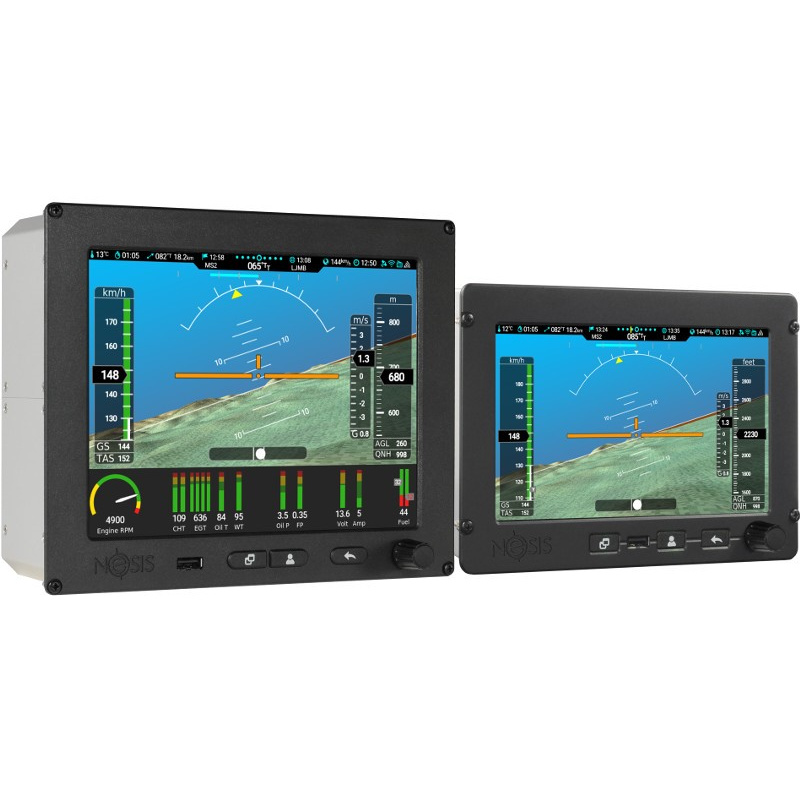Challenger LITE: 10.4” XVGA
$2 117.31
Description
These are full feature systems and require an iBOX unit which is the
central part of the system. One or two iBOX devices can share up to 8
panels.
Challenger Lite, Explorer Lite and Discovery Lite do not require an iBOX
and feature built in sensors and AHRS. These variants are intended for
aircraft not requiring the full interface capability and this results in lower
cost and simplified installation.
A typical system is shown on the right using a single iBOX. Wiring is
greatly reduced by being able to place the iBOX in a suitable location
while interconnections between the systems is minimized by using
effective network connections to panels and the well proven automotive
CAN network interface to devices.
The Explorer EFIS introduces a custom developed touch pressure sensitive
LCD screen aimed exclusively at the small aircraft application. With the
ability to accurately measure contact force in all conditions, it becomes
possible to utilize the user interface advantages of a touch screen even in
turbulent flight.
Unlike conventional touch screen technology, MGL’s “tap screen” can be
used with gloves, is completely unaffected by sunlight and even uses a
polarized anti reflective and anti glare film. The tap screen uses only high
quality optical glass in its construction and thus has no negative effects on
the image quality, even in difficult light conditions. The tap screen is further
qualified for zero pressure conditions such as experienced in space and is
not affected by sudden, large pressure changes.
Recognizing that some operations can never be fully replaced by a touch
screen, the Explorer adds no less than 5 “clickable” rotary controls which
assume functions depending on current need plus adds conventional,
tactile buttons for quick access to often used functions regardless of what
appears on the screen.
Quick, logical interactive user interface. Combine what is good with every
method.
Functionality in brief
Primary Flight instruments:
Altimeter, Airspeed, Vertical speed, AHRS, rate of turn, slip, angle of
attack.
Synthetic vision including 4 video sources (FLIR cameras etc), TAWS (on
synthetic vision and 2D maps).
Navigation system:
Built in WAAS GPS (50 channels), connectivity to external navigation
systems and radios. ARINC (G430 etc), VOR, ILS. Including built in
simulated ILS/Glide slope and VOR using GPS.
Voice annunciation and alerts
Engine monitoring:
Via external RDAC modules up to 4 engines, comprehensive sensor
connectivity. Suitable for any type of engine including turbines. RDAC
modules greatly reduce wiring.
Redundancy:
Systems from simple to complex redundancy can be constructed using
multiple sensors (AHRS etc), dual iBOX and mutiple panels. Master and
backup power supplies in various topographies suported.
“Lite” systems provide self contained panels that can share sensors.
Autopilot:
Supports external autopilots (NMEA and ARINC) as well as providing a
built in autopilot that can drive MGL servos directly.
The built in autopilot is one of the best in the industry and can fly even
“twitchy” aircraft in all conditions. Supports one, two or three axis servo
control. Autopilot includes lateral as well as vertical control and can fly
glide slopes.
Connectivity (iBox):
6 x RS232, 3 ARINC RX, 1 ARINC TX. 2 x CAN. Analog nav inputs,
analog/digital inputs, encoder output, general purpose outputs
“Lite”: 2 x RS232, 1 x CAN
Compatable Equipment
SP-7 “CAN” AHRS (up to 4 can be connected for redundancy, however
each iEFIS is also able to display a horizon based on accurate GPS
measurements).
SP-6 “CAN” Compass (up to two compass systems can be connected).
RDAC XF and RDAC XF MAP – MGL’s new engine monitor. Up to 4 of
these can be
connected which means you can monitor up to 4 engines (including
turbines).
MGL Servo – The CAN based servo is compatible, up to three can be
connected at this stage (Bank, Pitch and Yaw).
MGL V6 and MGL V10 VHF COM radios. These are fully compatibe. Up to
two can be
connected and controlled from any iEFIS panel.
MGL/Garrecht mode-s transponder. This remote mount transponder can be
fully controlled by the iEFIS panel.
MGL Navigation radio. Dual VOR, ILS, glide slope and marker receiver
(Currently in development).
MGL Flap/Trim motor controller. This CAN based interface can directly
drive a DC motor for flap and trim control.








Reviews
There are no reviews yet.